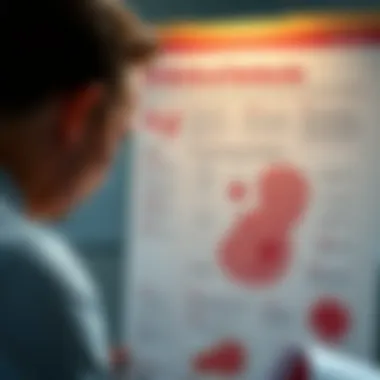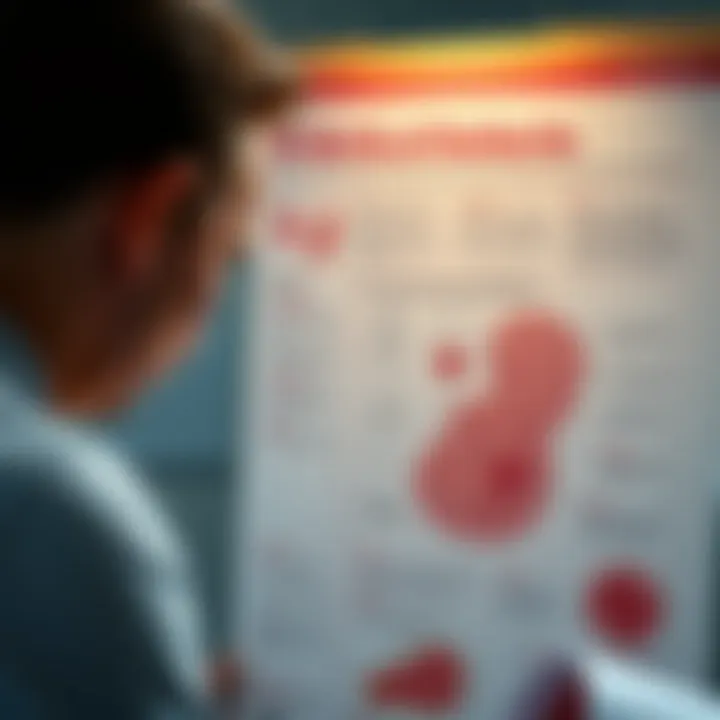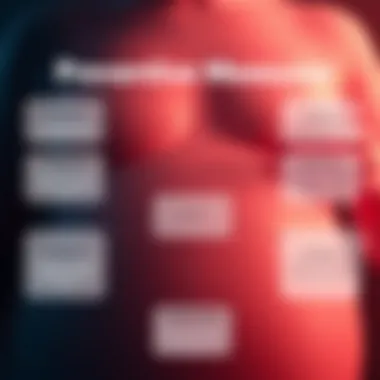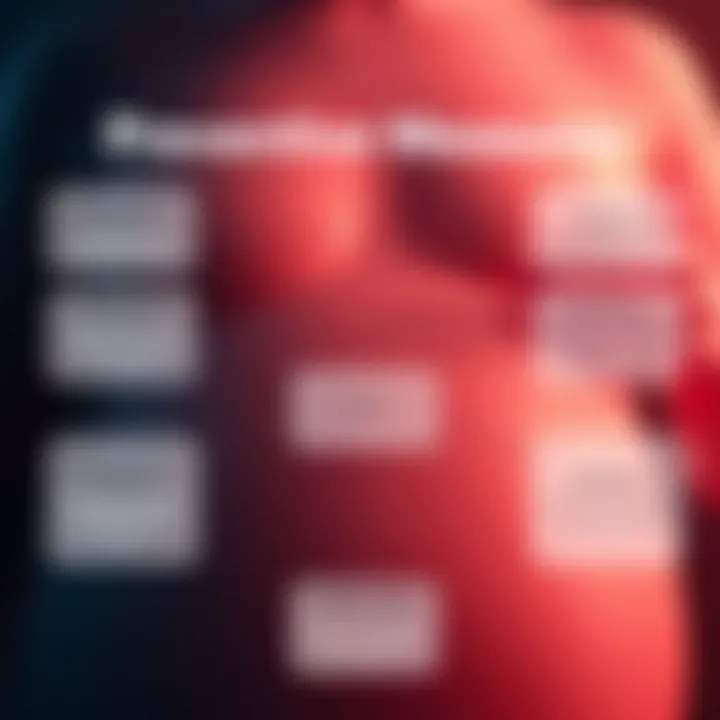Exploring Common Birth Defects: Types, Causes, and Impacts


Research Overview
Summary of Key Findings
In exploring common birth defects, recent studies highlight a myriad of anomalies that can occur during fetal development. It is estimated that about 1 in 33 newborns is born with a defect. Some of the most prevalent types include congenital heart defects, neural tube defects, and Down syndrome. Not only do these conditions vary widely in severity and impact, but they also possess a range of etiologies from genetic factors and environmental influences to maternal health issues.
Among findings, the prevalence of these defects has drawn attention to potential preventative measures. For instance, folic acid supplementation before and during early pregnancy has been linked to a decline in certain types of neural tube defects. A twist in recent research indicates that the timing of this supplementation plays a crucial role.
Methodologies Employed
Various methodologies have been employed to gather data about birth defects. Cohort studies, case-control studies, and meta-analyses of existing research serve as foundational techniques. Some researchers have employed innovative approaches, including genetic screenings and detailed interviews with affected families.
While analyzing such data, scientists take into account several factors such as maternal age, genetic background, and geographical differences, which can shape the results significantly. Utilizing registries and health records has also provided valuable insight into long-term outcomes for individuals with different types of birth defects.
In-Depth Analysis
Detailed Examination of Results
One noteworthy finding involves the identification of specific gene mutations associated with congenital heart defects. Researchers have pinpointed distinct biomarkers that appear during early embryonic development. This new knowledge is fostering advancements in prenatal diagnostics, allowing for enhanced preparation and intervention strategies.
Furthermore, comparisons with past studies illustrate how the prevalence of certain defects has shifted over the decades. For example, a marked decrease in cases of spina bifida has been documented, correlating with increased public health initiatives around maternal education and health.
Comparison with Previous Studies
Historically, studies have focused heavily on the genetic components of birth defects, with less emphasis on environmental and lifestyle factors. This article builds upon prior work by emphasizing the multifaceted nature of these conditions. It integrates findings that suggest a complex interplay between genes and environment—indicating that prevention strategies must also consider maternal dietary habits, exposure to toxins, and prenatal care access.
"Understanding the multifactorial nature of birth defects is key to implementing more effective public health policies that could save lives."
Utilizing a holistic approach enriches the discourse around birth defects, allowing for more comprehensive strategies aimed at reducing incidence rates and improving the quality of life for affected individuals.
Prelims to Birth Defects
Birth defects stand as a complex and profound challenge within the medical field, affecting countless families worldwide. These conditions arise during the critical phase of fetal development, often resulting in structural, functional, or metabolic anomalies that can influence an individual’s health throughout their lifetime. Understanding the nuances of these defects is crucial not only for medical professionals but also for educators, families, and researchers who seek to alleviate their impact.
The significance of discussing birth defects cannot be overstated. For one, they represent a significant contributor to infant mortality and lifelong disability. This makes it all the more vital to grasp the various factors that can lead to these conditions, which range from genetic predispositions to environmental influences. Increased awareness can pave the way for better prenatal care, enhancing the financial and emotional well-being of expectant parents.
Birth defects can take myriad forms, impacting areas such as heart function, skeletal structure, and even metabolic processes. The article will delve into specific categories, examining how certain defects manifest, what symptoms they present, how they are diagnosed, and the potential long-term outcomes for affected individuals. Recognizing these critical areas will empower parents with knowledge, enabling them to seek timely interventions that may alleviate challenges down the line.
Moreover, it is essential to consider the wider societal implications of birth defects. The economic burden they impose on families and the healthcare system is staggering. Children with birth defects often require specialized care, prolonged hospital stays, and ongoing therapies. This not only strains familial resources but affects public health funding and social support systems as well. Therefore, understanding birth defects extends beyond the individual to encompass wider community health considerations.
In this article, we will explore each facet of birth defects—from definitions and prevalence to the major categories and specific examples—offering readers an enlightening overview aimed at stirring informed conversations among students, researchers, and healthcare professionals. By combining recent scientific advancements with expert insights, we hope to facilitate a deeper understanding of these critical health issues and the ongoing efforts to improve outcomes for those affected.
"Knowledge is power, especially when it comes to understanding the challenges many families face."
As we dive into subsequent sections, the aim is to foster awareness and, ultimately, hope for a future marked by reduced incidences of birth defects, ensuring healthier beginnings for generations to come.
Understanding Birth Defects
Understanding birth defects is a pivotal aspect of maternal-fetal medicine. Recognizing the complexities surrounding these conditions can serve as the foundation for informed decisions by expectant parents as well as healthcare providers. In this segment, we will discuss key elements that make awareness of birth defects more than just necessary; it’s vital.
Why is Understanding Birth Defects Important?
- Early Intervention: Grasping knowledge regarding birth defects can lead to early detection and intervention. Early diagnosis often translates into better health outcomes. Parents can plan for necessary treatments and therapies from the onset.
- Education and Awareness: Education plays a critical role in the understanding of birth defects. By disseminating information to parents and the general public, we can significantly reduce stigma and enhance support for affected families.
- Informed Choices: With a comprehensive grasp of what causes birth defects, parents can make better lifestyle choices pre and post-pregnancy, fostering healthier outcomes for their children.
- Policy Development: Heightened awareness leads to increased advocacy, which can drive improvements in healthcare policies related to maternal and fetal health.
Through a well-rounded understanding of birth defects, both mental and physical health pathways can be enhanced in society.
Definition and Overview
Birth defects refer to structural or functional anomalies that occur during fetal development. These defects may affect a child’s health, appearance, or the way their body works. They can stem from a variety of origins, including genetic factors, environmental influences, or a combination of both.
Understanding the types of birth defects can aid in clarifying their consequences. Let's explore the primary categories:
- Structural Defects: These refer to physical issues with body parts, such as congenital heart defects or spine disorders.
- Functional Defects: These are often less visible but affect how the body operates, such as metabolic disorders.
The impact of these defects can vary widely — some require minimal intervention, while others may necessitate lifelong care.
Prevalence of Birth Defects
Birth defects are more common than many suppose. Statistics indicate that in the United States alone, about 1 in every 33 babies is born with a birth defect. This statistic translates roughly into 120,000 infants annually experiencing some form of congenital anomaly. Notably, the prevalence may differ based on several factors such as:
- Geographic Variability: Rates of specific birth defects may vary in different regions due to environmental factors
- Ethnic Background: Certain conditions may show higher prevalence rates in specific ethnic groups, highlighting the need for tailored public health strategies.
- Maternal Age: Older maternal age is often associated with increased risk for chromosomal abnormalities, which can lead to things like Down syndrome.
These numbers are startling but emphasize the importance of continued research and awareness. It’s imperative that we collectively enhance our understanding of the underlying factors and consequences that accompany birth defects.
"Understanding birth defects isn’t just about numbers; it’s about lives and futures. As we delve deeper into their causes, we uncover essential solutions that can lead to better outcomes."
Major Categories of Birth Defects
Birth defects can broadly be categorized into two main types: structural and functional defects. Understanding these categories is essential as it helps clarify the various ways in which fetal development can go awry. Each category contains unique conditions that affect infants, and they require different approaches for diagnosis, treatment, and long-term care. Approaching birth defects from a categorical standpoint not only paves the way for better understanding but also supports more targeted research and public education efforts. By focusing on specific defects, professionals can enhance prevention strategies and improve outcomes for affected individuals and their families.
Structural Defects
Structural defects are some of the most visible congenital anomalies. They can influence how organs and systems form and function, significantly impacting the child’s quality of life. This category encompasses a range of serious conditions that can affect various parts of the body.
Heart Defects
Heart defects, such as septal defects or tetralogy of Fallot, are critical because they directly affect the circulatory system. These anomalies can lead to life-threatening scenarios if not addressed promptly after birth. One key characteristic of heart defects is their prevalence; they are among the most common types of birth defects identified at birth. On the plus side, with advancements in surgery and medical care, many children can go on to lead healthy, active lives. The unique feature of heart defects lies in their complexity, which often involves multiple anatomical considerations that require tailored treatment plans. The need for ongoing monitoring can be seen as a disadvantage, as the health implications may necessitate regular check-ups into adolescence or even adulthood.
Spinal Disorders
Spinal disorders, including conditions like spina bifida, showcase the range of difficulties that can affect the nervous system. These defects can lead to varying degrees of disability, depending on the severity and the point of the spinal cord affected. They serve as a reminder of how crucial proper neural development is during pregnancy. A notable aspect of spinal disorders is that they can sometimes be detected early through prenatal imaging techniques. This allows for informed decision-making and care planning. However, the challenges faced by families often include a lifetime of medical management and physical therapy, which can be burdensome.


Facial Anomalies
Facial anomalies, such as cleft lip and palate, are visually striking and can affect eating, speaking, and the overall aesthetics of a person. Their significance in this discourse comes from both a medical and a social perspective. Here’s where cultural perceptions of beauty intertwine with health issues, making the impact of these anomalies more pronounced. Fortunately, advancements in reconstructive surgery have transformed the lives of many individuals born with these conditions, allowing for significant improvements in their quality of life. Still, the unique feature of facial anomalies often involves psychological challenges related to self-esteem and acceptance, which can persist even after physical repairs.
Functional Defects
Functional defects differ from structural defects in that they primarily affect bodily functions rather than the physical structure of organs. These can range from metabolic conditions to genetic disorders, and they can have profound implications for an individual’s health and development.
Genetic Disorders
Genetic disorders, including conditions like Down syndrome or cystic fibrosis, arise from abnormalities in an individual's DNA. They represent a significant concern in the realm of birth defects because they can affect the mind and body in pervasive ways. A key characteristic of genetic disorders is their hereditary nature, often being passed down through generations. The beauty of this topic lies in its ability to inspire future research and intervention strategies. However, the downside is that these disorders often require comprehensive management throughout the individual’s life, including specialized educational plans and increased healthcare utilization.
Metabolic Conditions
Metabolic conditions encompass disorders in which the body’s ability to convert food into energy is impaired. These defects can vary widely in their repercussions, from relatively benign conditions to severe issues that can have profound impacts on health. A principal characteristic of metabolic conditions is that many are treatable with dietary adjustments if caught early. This early intervention can offer a significant advantage in enhancing long-term health outcomes. However, the challenge remains that some families may face a steep learning curve in managing their child’s condition over time, which can create stressors and require ongoing support.
Common Birth Defects in Detail
The topic of common birth defects holds considerable significance in the realm of healthcare and genetics. Understanding these defects can illuminate various facets of prenatal care and child development. For expectant parents, healthcare professionals, and educators, acquiring knowledge about specific birth defects can lead to improved outcomes and foster empathy towards affected individuals and families. By diving into the details of these conditions, we further our collective awareness and can better shape preventative strategies.
Congenital Heart Defects
Types and Classification
Congenital heart defects are a blend of structural issues within the heart that arise during fetal development. The types and classification of these defects vary widely, but their categorization into major types such as atrial septal defects and ventricular septal defects is crucial in medical practice. By classifying these defects based on their position and nature, healthcare providers can customize treatment strategies effectively.
One key aspect of this classification is its role in streamlining diagnosis and enabling prompt interventions. For instance, an atrial septal defect will typically require specific surgical approaches compared to a ventricular septal defect. This clarity not only aids in treatment planning but sets clear expectations for families coping with the implications of a congenital heart defect. However, the complexity of these classifications can also pose challenges. Some defects may have overlapping symptoms, making diagnosis initially perplexing for medical professionals.
Symptoms and Diagnosis
Understanding the symptoms and diagnosis of congenital heart defects serves as a cornerstone in unraveling these complex conditions. Common symptoms such as difficulty breathing, fatigue, and poor weight gain can signal underlying issues that necessitate thorough examination. Advanced diagnostic tools like echocardiograms and electrocardiograms enable accurate identification of these defects, presenting an essential step towards treatment.
One significant aspect of these diagnostic methods is their non-invasive nature. They allow for a comprehensive evaluation without posing risks to the patient, which is particularly important for infants. However, it’s also vital to note that early signs might be subtle, and without vigilant monitoring, some defects can remain undetected until later stages of childhood. Thus, advocacy for regular check-ups becomes key.
Long-Term Prognosis
The long-term prognosis for children with congenital heart defects can vary significantly based on the type and severity of the defect. Early diagnosis and intervention can lead to much better outcomes, with many children leading full, active lives. Assessing the prognosis involves considering various elements such as surgical success rates, possible complications, and the child’s overall health.
A standout feature of this prognosis is its evolving nature; continuous advancements in medical technology and surgical techniques pave the way for improved future outcomes. While it's positive to highlight these advancements, it is equally imperative to address the psychological and emotional effects on both the child and family. Navigating potential complications down the line can create a layer of uncertainty, requiring robust support systems for both patients and their families.
Spina Bifida
Forms of Spina Bifida
Spina bifida presents itself in several forms, with variations such as spina bifida occulta, meningocele, and myelomeningocele. Each type displays a different level of severity, impacting how a child is treated and supported. The distinction among these forms lies in the degree of nerve damage and the surgical interventions necessary for managing the condition.
Recognizing the various forms helps families understand the specific challenges their child may face, which in turn can foster more effective support networks. However, it is also crucial to note that knowledge of these forms can lead to uncertainty over potential outcomes, adding a layer of stress for families.
Associated Complications
Associated complications with spina bifida can impact not just the physical but emotional well-being of both the child and their family. Issues such as hydrocephalus, mobility challenges, and bladder dysfunction are commonly reported. Properly understanding these complications plays a vital role in healthcare planning, guiding treatment plans that best suit the needs of the child.
While modern advancements provide options for managing complications, they may also create a patchwork of ongoing medical needs that can strain family resources. This highlights the importance of a holistic approach in care, one that considers both physical and psychological aspects of treatment.
Treatment Options
Treatment options for spina bifida can range from surgical interventions to physical therapy, each tailored to the individual needs of the child. Immediate surgical repair post-birth may be necessary in certain severe cases, while ongoing therapy can greatly enhance mobility and functional skills.
One attractive feature of modern treatment is the ability to personalize approaches based on the specific characteristics of each case. However, there is a catch; the complexity of treatment plans can lead to medical burnout among families. Navigating ongoing healthcare can become overwhelming without adequate supports and resources in place.
Cleft Lip and Palate
Causes and Risk Factors
The causes and risk factors associated with cleft lip and palate are diverse, ranging from genetic predispositions to environmental factors. Parents may find solace in understanding the multifaceted origins of this condition, including potential maternal health aspects.
This comprehensive view allows for greater engagement in prenatal care. However, potential parents might feel anxiety over perceived preventability — or lack thereof — leading to feelings of guilt. Providing clear information on this aspect as part of public health campaigns is essential.
Reconstructive Surgery
Reconstructive surgery is a critical treatment option for children with cleft lip and palate, often performed early in life to aid appearance and functional capabilities. Surgical procedures can significantly improve speech and feeding, two vital elements in a child’s development.
One notable characteristic of reconstructive surgery is its ability to enhance not just physical appearance but also the psychological outlook of children as they grow, promoting social interactions. However, these surgeries require multiple interventions over the years, which can burden families emotionally and financially.
Impact on Feeding and Communication
The impact of cleft lip and palate on feeding and communication cannot be understated. Many infants with this condition face challenges in feeding, necessitating specialized feeding techniques and tools. Additionally, delayed speech development can pose hurdles in socialization and self-esteem as children interact with peers.
This aspect emphasizes the need for an interdisciplinary approach, involving speech therapists and nutritionists to facilitate overall development. Nonetheless, balancing early intervention strategies with personal feelings of inadequacy in ability to cope can be a significant struggle, requiring ample community support.
Comprehensive knowledge on common birth defects not only aids in medical interventions but also builds empathy and awareness in society, strengthening the support systems for affected families.
In summary, understanding common birth defects provides parents, professionals, and researchers alike with an invaluable roadmap to navigate the complexities surrounding these conditions, paving the way for better caregiving and support mechanisms.
Causes of Birth Defects
Understanding the causes of birth defects is crucial. It creates a foundation for grasping how these anomalies can impact fetal development and, ultimately, the lives of those affected. Identifying these causes can facilitate preventive measures, support for families, and late interventions that could mitigate the effects on new lives. Addressing both genetic and environmental factors is essential as they collectively weave together the narrative of birth defects. This section provides clarity about how specific elements contribute to the formation of these conditions.
Genetic Factors
Genetic factors are pivotal when exploring the roots of birth defects. They highlight the complex interplay of heredity and anomalies in normal genetic functions.
Chromosomal Aberrations


Chromosomal aberrations play a significant role in genetic development. These are deviations from the normal number, structure, or arrangement of chromosomes. Such changes can lead to conditions like Down syndrome, which is a result of an extra copy of chromosome 21. A distinctive feature of chromosomal aberrations is how they can alter developmental processes, leading to various health issues. Their importance in this article lies in illustrating the serious implications such alterations can bring upon an individual’s life from birth onward.
Highlighting aspects like the contribution of chromosomal aberrations leads to increased awareness of genetic counseling methodologies available today. Advantages include early detection, but constraints may also manifest, as detecting disruptions does not always guarantee positive outcomes for affected pregnancies.
Hereditary Conditions
Hereditary conditions are another layer to consider within genetic factors. These conditions arise from gene mutations passed down from parents. Examples include cystic fibrosis and sickle cell anemia. The key characteristic of hereditary conditions is the predictability in their transmission within families. This aspect makes it a useful point of focus for this article since understanding family genetics can inform expectations for future generations.
The uniqueness of hereditary conditions lies in their diverse manifestations and potential severity, providing clinicians and families with vital insight regarding management and care. Advantages of this understanding include the potential for targeted treatments; however, disadvantages arise when considering the emotional weight on families as they navigate the implications of hereditary risks.
Environmental Influences
Beyond genetics, environmental influences are significant contributors to the occurrence of birth defects. These factors often interact with genetic predispositions, making their study essential.
Teratogenic Agents
Teratogenic agents are environmental substances or factors that can induce birth defects during pregnancy. Agents such as alcohol, certain medications, and infections can significantly affect fetal development. The key characteristic of teratogenic agents is their ability to cause harm during critical periods of fetal growth. This allows for a focused discourse on prevention and education in this article, aiming to raise awareness regarding avoidable risks.
The unique aspect of teratogenic influence is its determinable effect on organogenesis, emphasizing a proactive approach in maternal health practices. While understanding teratogenic agents can boost preventive strategies, restrictions occur when exposure is unrecognized until it's too late, leading to devastating outcomes that could have otherwise been prevented.
Maternal Health and Nutrition
Maternal health and nutrition encompass a broader scope, highlighting how the well-being and dietary choices of expectant mothers can shape fetal outcomes. This facet of environmental influence is critical, as it ties into the woman’s lifestyle, providing insights into nutrition’s role in development.
The key characteristic of this element lies in its immediacy and relatability – every pregnant woman is encouraged to consider these influences actively. Focusing on maternal health and nutrition provides a strong preventative message about maintaining a healthy pregnancy. Unique features include the importance of vitamins like folic acid in reducing the risk of neural tube defects, demonstrating a tangible actionable step for expectant mothers.
While the established benefits are clear, the limitations come from socioeconomic factors that can hinder access to proper nutrition and healthcare, often making it a multifaceted issue requiring systemic attention.
"Awareness of birth defect causes, whether genetic or environmental, is essential for informed preconception and prenatal care that could ultimately lead to healthier outcomes for both mother and child."
In summary, the causes of birth defects stem from a blend of genetic factors and environmental influences, each with their unique characteristics and implications. By comprehending these aspects thoroughly, both families and practitioners can adopt more effective prevention and care strategies to address the challenges posed by birth defects.
Further Reading
- National Birth Defects Prevention Network
- Centers for Disease Control and Prevention
- World Health Organization
Preventative Strategies
Preventative strategies are a cornerstone in mitigating the risks associated with birth defects. By implementing effective measures before and during pregnancy, individuals can significantly decrease the incidence of anomalies. Understanding the importance of such strategies not only highlights their critical role in maternal and fetal health but also serves as a proactive approach to address a complex medical issue.
Preconception Care
Genetic Counseling
Genetic counseling stands out as an essential aspect of preconception care. This process involves a thorough evaluation of family medical history and environmental factors that might affect fetal development. One of the key characteristics of genetic counseling is its personalized approach, tailoring advice and recommendations based on an individual's unique situation.
The decision to engage with genetic counseling can be particularly beneficial, especially for those with a family history of genetic disorders or anomalies. These counseling sessions offer insights into the risks, testing options, and the implications of potential genetic conditions. A unique feature of genetic counseling is its ability to empower parents with knowledge. They can make informed choices regarding their reproductive options, which can be invaluable in reducing the likelihood of birth defects.
However, there are also disadvantages to consider. Some individuals may find the process emotionally taxing, as confronting potential genetic risks can be overwhelming. Moreover, access to genetic counseling can vary widely, affecting its utility for those in remote or underserved regions. Here’s a brief rundown of the advantages and disadvantages:
- Advantages:
- Disadvantages:
- Personalized risk assessment
- Informed decision-making
- Educational resources on genetic disorders
- Emotional stress from confronting potential risks
- Limited access in some areas
Healthy Lifestyle Choices
Healthy lifestyle choices are another pivotal element in preventing birth defects. Focusing on optimal nutrition, avoiding harmful substances, and maintaining a healthy weight can positively influence fetal health. A key characteristic of these choices is their accessibility; many can be adopted without extensive resources.
Choosing a balanced diet rich in vitamins and minerals, such as folic acid, can significantly reduce the risk of neural tube defects. This emphasis on nutrition is part of a larger picture that places individuals in the driver's seat regarding their health. Another unique feature of embracing healthy lifestyle choices is their wide-ranging benefits—improved overall well-being for the mother, which can lead to a more favorable pregnancy outcome.
Nevertheless, the reality is that making healthy choices can sometimes be challenging. Factors like stress, lack of access to healthy food, or misinformation can complicate efforts. Here’s a snapshot of the advantages and disadvantages:
- Advantages:
- Disadvantages:
- Improved maternal health
- Reduced likelihood of birth defects
- Overall better pregnancy outcomes
- Access to resources may vary
- Changing habits can be difficult
Prenatal Screening and Diagnosis
Prenatal screening and diagnosis play a crucial role in understanding and managing potential birth defects. Early detection can provide families with valuable information, allowing for informed decisions and planning.
Ultrasound and Imaging Techniques
Ultrasound and imaging techniques are fundamental tools for prenatal care. They allow for visual assessment of fetal development, making them indispensable in detecting potential abnormalities early in pregnancy. The central feature of these techniques is their non-invasive nature, enabling parents to gain insights into fetal health without risks associated with invasive procedures.
One notable aspect of ultrasound is its ability to monitor not only structural development but also aspects like blood flow and organ function. These observations can lead to timely interventions if necessary. However, while they are widely accepted and beneficial, some people may have concerns over the resolution of ultrasound imaging and the possibility of false positives. Here’s a summary of advantages and disadvantages:
- Advantages:
- Disadvantages:
- Non-invasive and safe for mother and child
- Immediate assessment of fetal health
- Early detection of potential issues
- Possible false positives or negatives
- Limited in diagnosing certain conditions
Genetic Testing
Genetic testing represents another vital component of prenatal screening. This process involves analyzing fetal DNA to detect genetic disorders and abnormalities at an early stage. The strength of genetic testing lies in its precision and ability to provide clear information about genetic risks.
A significant characteristic of this testing is the range of options available, including non-invasive prenatal testing (NIPT). NIPT is particularly beneficial because it poses no risk to the fetus. It helps parents understand their baby's genetic health without resorting to invasive measures, such as amniocentesis. Nonetheless, potential drawbacks include the emotional burden of results and the interpretation complexities that may arise. Below is a quick overview of advantages and disadvantages:
- Advantages:
- Disadvantages:


- High accuracy in detecting genetic conditions
- Non-invasive options available
- Informed choices about care and support
- Potential for emotional distress upon receiving results
- Misinterpretation of complex genetic data
Impact on Families and Society
The impact of birth defects on families and society is profound and multi-faceted, encompassing emotional, psychological, and economic dimensions. Understanding these elements is crucial not only for affected families but also for informed policymakers and healthcare providers. By recognizing the intricate interplay between the challenges faced by families and the broader societal implications, we foster an environment that encourages support and development in care practices, healthcare funding, and community awareness.
Emotional and Psychological Effects
Parental Concerns
Parental concerns surrounding birth defects can significantly influence the overall family dynamic. When a child is born with a defect, parents often grapple with a storm of emotions–from confusion and sadness to guilt and anxiety. Many parents worry about their child’s future: Will they face physical limitations? Will they struggle in social settings? These thoughts can overshadow the joy of welcoming a new life.
This facet of parental experience highlights the key characteristic of uncertainty in prognosis. The lack of clear information can lead to continued anxiety. Hence, many families seek additional resources or forums where they can share their experiences and gather knowledge. For instance, community support groups can help dissipate feelings of isolation among parents, offering a beneficial network of shared experiences.
A unique feature of addressing parental concerns is the potential for personal growth. Parents often emerge stronger and more resilient. However, it's crucial to recognize that while sharing experiences can be symbiotic, it can also lead to emotional overwhelm, as parents may unintentionally adopt the worries of others as their own.
Support Systems
Support systems play a crucial role in helping families navigate the challenges associated with birth defects. Friends, fellow parents, and healthcare providers constitute the pillars of these systems. Coordinated care can yield significant relief for families grappling with the emotional toll of caring for a child with a defect.
The key characteristic of well-structured support systems is their capacity to provide both emotional and practical assistance. When parents feel supported, it can ease feelings of stress and hopelessness. Social networks can foster resilience, empowering families to focus more on their child’s strengths rather than their disabilities.
A unique feature of support systems is their ability to create connections. Online platforms, like forums or Facebook groups, allow parents to interact and share resources on a wide scale. However, it's essential to note that not all information shared in these settings is accurate, so parents must navigate the waters with discernment to avoid misinformation.
Economic Burden
Healthcare Costs
Healthcare costs associated with managing birth defects can escalate rapidly, creating a daunting financial strain for families. Many parents find themselves overwhelmed with bills for regular checkups, specialized therapies, and surgical interventions. This aspect highlights the key characteristic of unpredictability in expenses. For families with limited resources, this can be particularly devastating, often causing ripple effects that extend into other areas of life.
Understanding healthcare costs sheds light on why budgeting becomes crucial. Many families must adapt their financial planning to accommodate unforeseen expenses, leading to potential long-term stress. The case for public health funding and insurance reforms becomes clear as these costs directly impact families’ abilities to provide care and nurture their children’s development, making it a beneficial choice for society to invest in preventative measures and support systems.
A unique feature in tackling healthcare costs is the growing focus on finding alternative funding options. Some families discover grants or scholarships available for children with special needs, relieving some of the financial pressures.
Long-Term Care
The need for long-term care often arises when a child is born with a significant birth defect. Families must consider not only immediate care but also lifelong support in some cases. This brings to light the key characteristic of ongoing commitment. As parents plan for their child's future, they must ensure that necessary resources and support systems are in place, which can be a daunting task.
Addressing long-term care significantly impacts the talk about public health services and accessibility. The advantage here is that when families are well-informed about resources available to them, they can better collaborate with educational and developmental programs, ensuring their child receives appropriate support.
Nonetheless, potential disadvantages include the emotional burden on families that may stem from feeling responsible for ensuring comprehensive care over many years. The weight of this responsibility can sometimes lead to neglect of parents’ needs. Having access to respite care or support organizations can help mitigate these challenges, providing much-needed breaks and emotional restoration for caregivers.
Future Research Directions
Understanding where the field of birth defects research is heading is crucial for both scientific and societal advancement. This section is particularly insightful as it concentrates on the future possibilities that exist in preventing and treating birth defects. By examining the latest advancements in genetic research and public health initiatives, we can reveal how new findings can lead to improved outcomes for affected individuals and their families.
Advancements in Genetic Research
CRISPR Technologies
One of the most significant developments in genetic research is the CRISPR technology. This powerful tool allows researchers to edit genes with remarkable precision. The beauty of CRISPR lies in its simplicity and effectiveness. Researchers can target specific areas of DNA to insert, delete, or modify genetic material, offering revolutionary potential for correcting mutations responsible for birth defects.
The key characteristic of CRISPR is its ability to make precise genetic changes, which could potentially reverse the effects of certain birth defects before they manifest. This aspect presents a beneficial prospect for families at risk, as it may pave the way for preventative measures.
However, there are unique features that also raise concerns. Ethical considerations about gene editing remain prominent. Potential unintended consequences, known as off-target effects, are a disadvantage that must be managed with careful screening and regulation. Thus, while CRISPR holds promise, its practical application in human genetics needs to be approached with caution.
Gene Therapy
Gene therapy is another groundbreaking area of research that aims to treat or prevent diseases by directly altering the genetic material of an individual. This approach could significantly alter the landscape of birth defects, especially those caused by single-gene mutations.
The key characteristic of gene therapy is its targeted action on specific genes. It seeks to replace a faulty gene or engineer cells to combat disease effectively. This means, in ideal circumstances, that therapies might correct genetic defects that lead to various birth anomalies, enhancing the quality of life for children born with conditions.
However, with great power comes great responsibility. The unique feature of gene therapy is the high costs involved and the need for rigorous clinical trials to ensure safety and effectiveness. While these treatments may offer groundbreaking solutions, the economic and logistical hurdles are substantial, making accessibility an ongoing issue.
Public Health Initiatives
Awareness Campaigns
Public health initiatives are vital for increasing knowledge and understanding of birth defects within communities. Awareness campaigns aim to disseminate important information about prevention, early signs of defects, and the need for healthcare. The role of such campaigns can not be understated, as they play a key part in educating parents and healthcare providers.
The key characteristic of awareness campaigns is their ability to reach vast audiences through various channels—social media, community events, and educational materials. This wide-ranging reach makes it a beneficial tool for informing society, encouraging proactive measures, and reducing stigma associated with birth defects.
A unique feature is the adaptability of these campaigns to meet the diverse needs of different communities. The downside may be insufficient funding or resources, limiting their effectiveness. But when implemented correctly, these initiatives can bridge the information gap effectively, saving lives through awareness.
Policy Development
Policy development is integral to improving outcomes for families affected by birth defects. It involves creating regulations and guidelines that support research funding, healthcare access, and educational programs. The advances in policy-making can dictate the pace of research and determine the availability of treatments and resources.
The key characteristic of policy development lies in its systematic approach to addressing health issues. It comprises strategies that are data-driven, leading to targeted interventions. This makes it a beneficial endeavor as it can secure necessary funding and support structures for ongoing education and treatment options.
However, unique features such as bureaucratic delays or lack of political will can hinder progress. While the intention behind policy development is positive, the complexities of implementing changes can be frustrating.
The End
In summary, understanding common birth defects is of paramount importance not only for the medical community but also for families and society at large. This article has navigated through the intricacies of birth defects, shedding light on various aspects such as their types, underlying causes, and potential impacts. The depth of this exploration emphasizes how crucial it is to acknowledge these conditions for timely interventions and support systems.
The examination of birth defects concludes with several key thoughts:
- Awareness and Understanding: Gaining knowledge about birth defects helps in dispelling myths and misconceptions that can surround these conditions. It fosters a more supportive environment for affected individuals and families.
- Prevention is Key: As highlighted throughout the article, proactive measures in prenatal care can significantly reduce the occurrence of birth defects. Whether through proper health practices or genetic counseling, informed decisions can pave the way for healthier pregnancies.
- Research and Innovation: The future of tackling birth defects lies in ongoing scientific inquiry and technological advancements. Policies supporting research are essential for developing new prevention strategies and treatment options. The potential of advancements like gene therapy and CRISPR holds promise for improving outcomes for those affected.
- Socioeconomic Considerations: The economic burden that birth defects impose on families and healthcare systems cannot be overstated. Awareness and education about risks can help in forming better support structures for families managing these challenges.
Thus, the information presented throughout this article aims to equip readers with the knowledge necessary to comprehend the complexities surrounding birth defects. By fostering a collective understanding, society can work towards better strategies for prevention, support, and advocacy. As awareness rises, so does the potential for change—making it imperative to keep these topics in the public eye.
"Knowledge is power; awareness is key to prevention and support."
For further information:
- Centers for Disease Control and Prevention (CDC)
- National Institutes of Health (NIH)
- World Health Organization (WHO)















